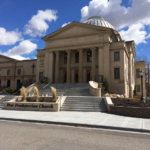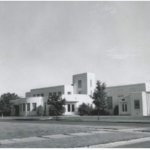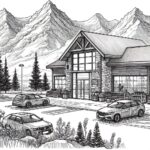Nestled in the heart of the majestic Teton Valley lies a hidden treasure trove of architectural marvels. From rustic log cabins to contemporary masterpieces, the diverse and timeless beauty of Teton Valley architecture is a sight to behold. Embark on a captivating journey through breathtaking designs and preservation, as we delve into the fascinating history and evolution of the region’s architectural landscape.
With its sprawling landscapes and stunning mountain vistas, Teton Valley has long been a source of inspiration for architects and designers. Each structure tells a story, reflecting the unique character of its surroundings. Rich in heritage and craftsmanship, the architecture of Teton Valley seamlessly blends with its natural environment, creating a harmonious blend of functionality and beauty.
Join us as we uncover the secrets hidden within these architectural gems, exploring the intricate details, innovative materials, and artistic expressions that define Teton Valley’s architectural legacy. From iconic landmarks to hidden gems, we will delve into the stories behind the structures, shedding light on the visionaries who have shaped the landscape and the preservation efforts that ensure their timeless beauty endures.
Experience the allure of Teton Valley architecture and be captivated by its enduring charm. This article is your guide to unlocking the hidden treasures within these breathtaking designs.
The history and evolution of Teton Valley architecture
The architectural narrative of Teton Valley is steeped in rich history, tracing back to the early settlers who sought refuge amidst its breathtaking landscapes. Initially, the valley was home to Indigenous peoples, who constructed simple yet effective shelters using locally sourced materials, harmonizing their dwellings with nature. As European settlers arrived in the late 19th century, they brought with them a variety of architectural styles that began to shape the valley’s identity. These early homes were predominantly log cabins, crafted from the abundant timber found in the surrounding forests. The rustic charm of these structures, with their rough-hewn logs and stone foundations, set the stage for a distinctive architectural language that would evolve over the decades.
As the 20th century unfolded, Teton Valley experienced a transformation driven by the burgeoning tourism industry. The demand for seasonal homes and lodges spurred the construction of more elaborate designs, often influenced by the Arts and Crafts movement. This era emphasized craftsmanship and the use of natural materials, leading to the creation of buildings that showcased intricate woodwork, artistic details, and a seamless connection to the landscape. The architectural style began to incorporate features like large windows that framed stunning views of the Teton Range, expansive porches for enjoying the outdoors, and open floor plans that encouraged community and family gatherings.
Entering the 21st century, Teton Valley architecture has seen a resurgence of interest in sustainable building practices and modern design philosophies. Architects and builders are increasingly focused on creating energy-efficient homes that minimize their environmental impact while maximizing comfort and aesthetic appeal. This evolution reflects a broader cultural shift towards sustainability and a deeper appreciation for the natural beauty that surrounds Teton Valley. The architectural landscape today is a mosaic of styles, blending traditional elements with contemporary innovations, all while honoring the valley’s historical roots and the stories embedded within its structures.
Key features of Teton Valley architecture
Teton Valley architecture is characterized by several distinctive features that reflect both the cultural heritage and the natural environment of the region. One of the most prominent elements is the use of local materials, particularly wood and stone. Log construction remains a hallmark of the area, with many homes showcasing the beauty of hand-hewn logs that create a warm and inviting aesthetic. These materials not only provide structural integrity but also resonate with the surrounding landscape, allowing buildings to blend effortlessly into their natural settings.
Another key feature is the emphasis on large windows and open spaces. Homes in Teton Valley are designed to embrace the stunning views of the Teton Mountains and the surrounding wilderness. Expansive glass walls and strategically placed windows invite natural light to flood the interiors, creating bright and airy living spaces. This design philosophy encourages a connection with the outdoors, allowing residents to experience the changing seasons and the beauty of nature from the comfort of their homes. Additionally, open floor plans are common, fostering a sense of community and togetherness among family members and guests.
Architectural details also play a significant role in defining Teton Valley’s unique aesthetic. Many structures incorporate handcrafted elements, such as artisanal woodwork, stone masonry, and decorative metal accents. These intricate details not only enhance the visual appeal of the buildings but also reflect the craftsmanship and dedication of the artisans who create them. Furthermore, the use of outdoor living spaces, such as wraparound porches, decks, and patios, extends the living area beyond the confines of the home, allowing residents to fully immerse themselves in the breathtaking surroundings. This combination of local materials, expansive designs, and artistic details contributes to the timeless beauty of Teton Valley architecture..
Influences on Teton Valley architecture
The architectural landscape of Teton Valley has been shaped by a variety of influences over the years, each contributing to the unique character of the region. One significant influence is the natural environment itself. The majestic Teton Range serves as a constant source of inspiration, prompting architects and builders to design structures that not only harmonize with the landscape but also withstand the harsh mountain climate. The use of durable materials and designs that prioritize energy efficiency reflects an understanding of the need for resilience against the elements, further embedding the natural context into the architectural narrative.
Cultural influences also play a crucial role in the evolution of Teton Valley architecture. The blend of Indigenous traditions with European settler styles has created a rich tapestry of architectural expression. This fusion is evident in the use of traditional building techniques, such as log construction, alongside more contemporary designs that incorporate modern amenities and sustainable practices. The Arts and Crafts movement, which emphasizes craftsmanship and a connection to nature, has left a lasting mark on the valley, inspiring many architects to create homes that celebrate artisanal skills and local materials.
In recent years, the influence of contemporary architectural trends has become increasingly prominent in Teton Valley. As more people seek vacation homes and retreats in this picturesque region, architects are integrating modern design elements that prioritize open spaces, minimalist aesthetics, and eco-friendly practices. This contemporary approach often involves the use of innovative materials, such as steel and glass, alongside traditional wood and stone, resulting in a striking contrast that celebrates both the past and the future. The ongoing dialogue between these influences ensures that Teton Valley architecture remains dynamic and ever-evolving, reflecting the changing needs and desires of its inhabitants.
Preservation efforts and organizations in Teton Valley
As Teton Valley continues to evolve, there is a growing awareness of the importance of preserving its architectural heritage. Various organizations and initiatives have emerged to safeguard the region’s unique structures and promote the value of historical preservation. One prominent organization is the Teton Valley Historical Society, which is dedicated to documenting and preserving the valley’s history, including its architectural landmarks. Through educational programs, community events, and advocacy efforts, the society works to raise awareness about the significance of preserving the valley’s architectural treasures.
Another key player in preservation efforts is the Teton Regional Land Trust, which focuses on protecting the natural landscapes and cultural heritage of the area. By collaborating with landowners and local governments, the trust aims to conserve the scenic beauty and historical significance of Teton Valley. Their initiatives often include conservation easements that prevent development on sensitive lands, ensuring that the architectural heritage remains intact and that the character of the valley is preserved for future generations.
Local government initiatives also play a crucial role in promoting preservation efforts. Zoning regulations and building codes are designed to protect the architectural integrity of Teton Valley, encouraging developers to consider the historical context and aesthetic value of their projects. Public engagement and community input are essential components of this process, as residents are often the most passionate advocates for preserving the unique charm of their hometown. Through these collaborative efforts, Teton Valley is committed to honoring its architectural heritage while accommodating growth and modern development.
Exploring the iconic architectural landmarks of Teton Valley
Teton Valley is home to a myriad of iconic architectural landmarks that tell the story of the region’s rich history and cultural heritage. One of the most celebrated structures is the historic St. John’s Episcopal Church, which dates back to the early 1900s. With its charming stone façade and stunning stained glass windows, the church stands as a testament to the craftsmanship of its time. Its picturesque setting amidst the valley’s natural beauty makes it a beloved landmark for both locals and visitors alike, serving as a hub for community gatherings and spiritual reflection.
Another notable landmark is the Teton Valley Museum, housed in a beautifully restored historic building. This museum not only showcases the valley’s history but also highlights the architectural significance of the structure itself. The blend of modern exhibits with the building’s original features creates a unique experience for visitors, offering insight into the valley’s past while celebrating its architectural legacy. The museum serves as a vital resource for education and preservation, ensuring that future generations understand the importance of Teton Valley’s historical architecture.
Additionally, the iconic Grand Targhee Resort stands out as a prime example of modern architecture that pays homage to the valley’s natural landscape. The resort’s design incorporates sustainable practices and local materials, providing guests with a luxurious experience while maintaining a strong connection to the environment. With its stunning views of the Teton Mountains and abundant outdoor activities, Grand Targhee has become a significant destination for those seeking adventure and relaxation in a breathtaking setting. Each of these landmarks contributes to the rich tapestry of Teton Valley architecture, reflecting the region’s history, culture, and commitment to preservation.
Contemporary trends in Teton Valley architecture
As the architectural landscape of Teton Valley continues to evolve, contemporary trends are emerging that reflect changing lifestyles, environmental concerns, and aesthetic preferences. One of the most prominent trends is the increasing emphasis on sustainability and eco-friendly building practices. Architects and builders are incorporating energy-efficient technologies, such as solar panels, geothermal heating, and advanced insulation systems, into their designs. This focus on sustainability not only benefits the environment but also aligns with the values of residents who seek to minimize their carbon footprint while enjoying the beauty of their surroundings.
Another significant trend is the rise of minimalist design principles that prioritize simplicity and functionality. Many new homes in Teton Valley feature clean lines, open spaces, and a neutral color palette, allowing the natural beauty of the landscape to take center stage. This minimalist approach creates a sense of calm and tranquility, reflecting the desire for a lifestyle that embraces nature and promotes well-being. Additionally, the use of large windows and open floor plans fosters a strong connection between indoor and outdoor spaces, encouraging residents to engage with the stunning vistas that define the valley.
The integration of smart home technology is also becoming increasingly popular in Teton Valley architecture. Homeowners are seeking innovative solutions that enhance convenience, security, and energy efficiency. From automated lighting systems to advanced climate control, these technologies allow residents to tailor their living environments to their specific needs while reducing energy consumption. As Teton Valley embraces these contemporary trends, the architectural landscape continues to reflect the region’s commitment to innovation, sustainability, and a deep appreciation for its natural setting.
Tips for incorporating Teton Valley architectural elements into your own home
For those looking to bring the charm of Teton Valley architecture into their own homes, there are several key elements to consider that can evoke the region’s timeless beauty. One of the most important aspects is the use of natural materials. Incorporating wood, stone, and other locally sourced materials can create a warm and inviting atmosphere that resonates with the rustic elegance of Teton Valley. Whether through exposed beams, wooden accents, or stone fireplaces, these features can establish a strong connection to the natural environment, enhancing the overall aesthetic of your home.
Another way to embrace Teton Valley’s architectural style is to prioritize large windows and open spaces. Designing your home with expansive glass walls or strategically placed windows can maximize natural light and frame stunning views of the surrounding landscape. Open floor plans that facilitate a sense of flow between rooms will not only create a more spacious feel but also encourage a communal atmosphere, perfect for family gatherings and entertaining guests. This emphasis on connectivity with nature and the outdoors is a defining characteristic of Teton Valley architecture that can be seamlessly integrated into any home.
Finally, consider adding artisanal touches and handcrafted details to your design. Unique elements such as custom woodwork, decorative metal accents, or locally inspired artwork can infuse your space with character and personality. Collaborating with local artisans or craftsmen can yield one-of-a-kind features that pay homage to the region’s rich heritage while adding a personal touch to your home. By thoughtfully incorporating these Teton Valley architectural elements, you can create a space that not only reflects the beauty of the valley but also provides a timeless and inviting sanctuary for you and your loved ones.
Conclusion: Celebrating the enduring beauty of Teton Valley architecture
In conclusion, Teton Valley architecture is a remarkable blend of history, culture, and natural beauty, showcasing the region’s rich architectural heritage. From the early log cabins of settlers to contemporary sustainable designs, the evolution of architecture in Teton Valley tells a story of resilience, creativity, and a deep connection to the landscape. The enduring appeal of the valley’s structures lies not only in their aesthetic charm but also in the stories they embody and the community they foster.
As we explore the key features, influences, and notable architects that have shaped Teton Valley’s architectural landscape, it becomes clear that preservation efforts are essential to maintaining this unique identity. Organizations dedicated to safeguarding the valley’s history and architectural heritage play a crucial role in ensuring that future generations can appreciate and learn from the beauty and significance of these structures.
Ultimately, the timeless beauty of Teton Valley architecture invites us to celebrate the harmonious relationship between built environments and the natural world. Whether through the incorporation of local materials, the embrace of sustainable practices, or the preservation of historical landmarks, the architectural legacy of Teton Valley will continue to inspire and captivate for years to come. By honoring this rich heritage, we can ensure that the stories and beauty of Teton Valley architecture endure, enriching the lives of all who call this breathtaking region home.




